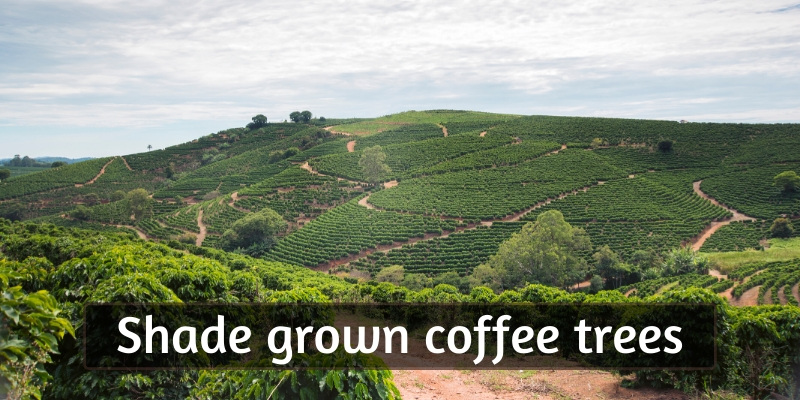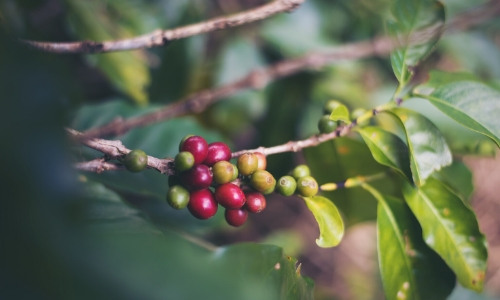Shade grown coffee seems to be a newly discovered wonder. You'll see it printed on labels and touted by more and more coffee shops.
Most people think there is something extra special about shade grown coffee, and there is. But the idea of growing coffee in the shade is not innovative, or unique.
As it is, this was the first place where wild coffee was discovered: under the shade of other trees. Let's take a closer look.
Table of Contents
What is shade-grown coffee?
Shade-grown coffee is practically a plantation of coffee trees that are growing under the shade of other trees.
This because the coffee tree is a plant requiring a great deal of shadow. Wild coffee grows naturally like this because it is highly sensitive and can't handle any extremes.
For that matter, all coffee plantations were shade-grown. I said "were" because nowadays sun grown coffee is the industry standard. Approximately 60% of coffee farms have become sun-grown since 1972.
On the other hand, regular (read: sun grown) coffee farms can be profitable for high crop yields, as the tree is under more stress, causing it to produce a larger number of blossoms and, therefore, cherries.
This method would deplete the soil too much, forcing the use of expensive fertilizers and pesticides.
For this reason, growing mixed cultivation provides shade, gives birds a nesting place and reduces the need for pesticides, fertilizers, and herbicides.
Main characteristics of shade-grown coffee
First of all, it is more sustainable for the farmers for two reasons: no need to use expensive fertilizers and pesticides to produce it, and shady trees can be a source of food.
There are countries where shady trees are papayas, oranges, mangos, bananas, and avocados.
Secondly, this method of growing coffee trees increases biodiversity. It is said that 52% of the world’s biodiversity has disappeared, but coffee farms have the power to slow down that trend. Also, trees are a natural filter for CO2.
So we're all better off if coffee is shade grown.
There are some shade grown coffee plantations that provide the perfect habitat for hundreds of species of beetles, bees, ants, more than 20 species of butterflies, and even small monkeys.
And after all of this, we all know that more trees means more oxygen for the planet. So win-win for everyone.
Unfortunately, just the small, low-tech farms, usually too poor to afford chemicals, preserved their shade trees.
And why are those farms in that position ? Because shade-grown coffee produces a much smaller crop yield.
To the point where it significantly reduces the profit each farm rakes in, and if every coffee farm were to produce only shade-grown coffee the world demand for coffee simply would not be met.
There just wouldn't be enough coffee for everyone.
Where does it come from?
It is a well-known idea that the homeland of the coffee tree is in Ethiopia. In history are a lot of different stories and myths, but an important fact is that the coffee tree grows in the wild among other trees.
This is the original way nature chooses to grow this plant, which today provides millions of cups of beverages.
But today, big companies with huge plantations need a way to grow coffee fast for large productions.
On the other hand more and more consumers are becoming aware of the impact coffee farms have on the planet, and are choosing shade grown coffee in an effort to help.
Is shade-grown coffee better?
Making a comparison between these two methods of planting coffee tree one thing is obvious. The benefits for biodiversity and the farmers. But what about the taste? Is it better?
Like with many other plants, growing without pesticides, fertilizers, and herbicides is a great thing. Today this is called organic coffee or specialty coffee.
But speaking of taste, there is a huge difference between them. Specialty coffee or organic coffee enjoys the natural environment, and this is how the taste is gonna be. Fresh, natural, full of aroma with notes of whatever is growing near the coffee tree.
For example, if a coffee tree grows near a papaya tree, then the final coffee will produce notes of papaya. Assuming that the processing and the roasting are well done.
And this is a great discovery in the world of coffee. Tasting a coffee with real and great aroma is priceless.
On the other side, growing coffee without shade and forcing the natural process is going to affect the taste. This sort of coffee will be more bitter, harsher, but will always have pretty much the same aroma since nothing else is growing near the tree.
Is shade-grown coffee more expensive?
Shade-grown coffee requires a lot of energy and care to be produced. Farmers works a lot to maintain good quality and adequate plant health. Even if they do not afford to use expensive fertilizers, herbicides, or pesticides, they compensate with hard work.
This is one of the reasons that coffee will be a little bit more expensive.
Another reason is that coffee will be of higher quality, this is a fair trade. Paying a little bit more for good coffee means that you are paying for the natural environment where coffee grows, as well as the labor put into that coffee.
You'll know your coffee is shade grown if
It has a label on it claiming it's shade-grown. Companies can't lie about the origin or production means of their coffee, but they are allowed to not say a word about it.
Seeing how shade grown coffee has become a consumer trend, companies that do grow their coffee this way will make it very easy to see.
Another label to look for is one that says the coffee farm is bird-friendly, or supports the ecosystem or has been grown responsibly.
Those are the usual trademarks of shade grown coffee and you might just find them on a label. Often these labels may be right next to a certified organic or Fairtrade label.
And finally, you can check the country of origin. Remember, companies can't lie about the origin buy they can choose to be quiet about it.
If your coffee comes from southern Mexico, El Salvador, Peru, Panama, Nicaragua, and Guatemala they're most likely shade grown. Those are smaller farms and would greatly benefit from your support.
You could also look for coffee from Sumatra, Timor, New Guinea and Ethiopia. Of course, there are some exceptions since not every single farm in those countries is shade-grown. Read the label carefully.
By comparison if you find coffee from Colombia, Brazil and Costa Rica (which are the most common) then it's almost certainly sun grown. Some shade farmers do exist, but they're in the minority.
Remember that these three countries are among the biggest coffee exporters, along with Indonesia and Vietnam.
If your favorite coffee brand has no mention of where the coffee comes from or how it's been produced (some don't even say if it's Arabica or Robusta) then it's safe to bet it's not a shade-grown coffee.
I hope this article managed to clear things up for you. Shade grown coffee is becoming a bigger topic by the minute, since it brings to light the impact farming has on the ecosystem.
Not only is it more flavorful but it's also much friendlier towards the local fauna. The extra penny or two is certainly worth it.
If you want to know more about coffee or tea, feel free to check the related articles below. Who knows what else you might find ?







